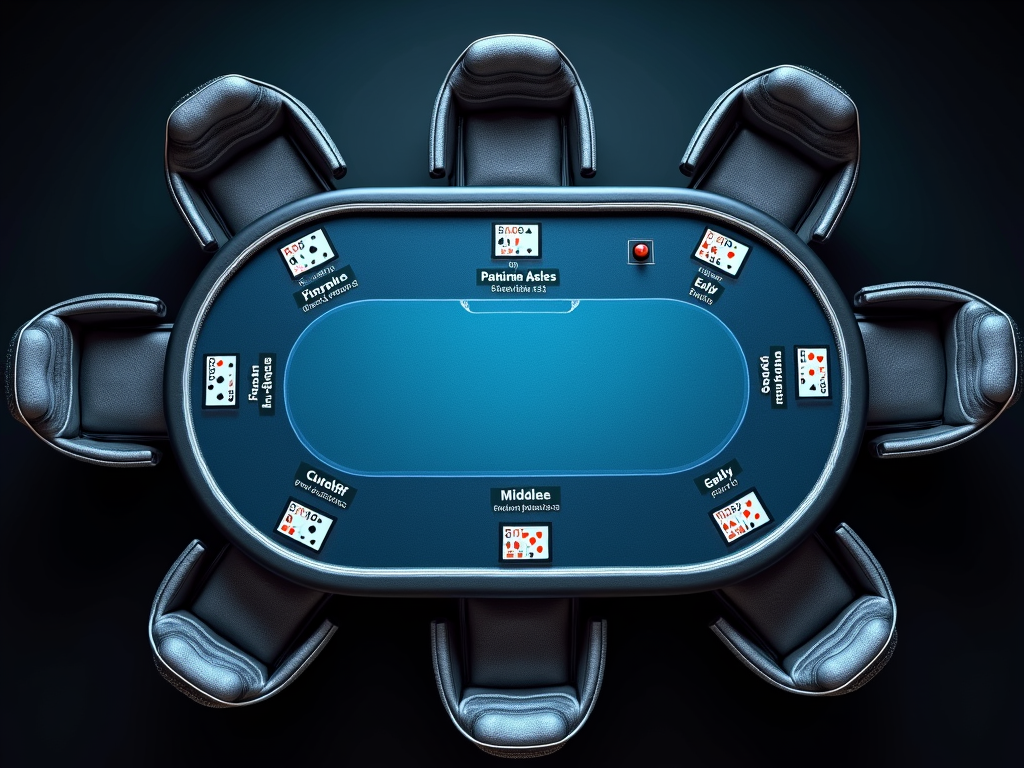The Importance of a Comprehensive Poker Glossary
A comprehensive poker glossary acts as the foundation for any poker player’s success, containing basic terms and sophisticated concepts about betting structures and position play. A clear understanding of these terms strengthens both communication and strategic decisions during gameplay.
Key Takeaways
- Essential money terms include ante, blinds, buy-ins, and rake, which form the financial foundation of poker games.
- Hand rankings follow a strict hierarchy from Royal Flush (rarest) to High Card (most common), with precise probability calculations for each.
- Core betting actions consist of bet, call, raise, check, fold, and all-in, each serving specific strategic purposes.
- Different betting structures (fixed-limit, pot-limit, no-limit) significantly impact gameplay and strategy.
- Table position greatly influences optimal play, with late position offering the strongest strategic advantages.
I find that mastering poker terminology opens up new strategic possibilities and helps players integrate seamlessly into any poker environment. Knowledge of specific terms enhances gameplay analysis and decision-making speed. The language of poker creates a shared understanding between players, making games run smoothly and efficiently.
Learning and Applying Poker Terms
Players should start by learning basic terms before advancing to more complex concepts. This progressive approach builds confidence and competence. Success at the poker table depends on combining theoretical knowledge with practical application of these terms in real game situations.
Continued Improvement Through Practice
Continuous study and practice with poker terminology leads to improved performance and deeper strategic understanding. A solid grasp of poker language marks the difference between casual players and serious competitors.
Essential Poker Terms Every Player Must Know
Key Money Terms and Table Mechanics
Before sitting down at a poker table for your first game, understanding the financial aspects is crucial. Let me break down the essential money-related terms you’ll encounter.
The ante is a forced bet that all players must contribute before receiving cards. In tournament play, it’s typically set at 10-12.5% of the big blind, creating immediate action and preventing overly tight play.
Blinds are mandatory bets posted by two players before each hand. The small blind sits to the left of the dealer and posts half the amount of the big blind, who sits to their left. For example, in a $1/$2 game, the small blind posts $1 while the big blind puts up $2.
Buy-in amounts vary by game format. In cash games, I recommend starting with 100 big blinds – that’s $200 in a $1/$2 game. Tournament buy-ins are fixed amounts set by the organizer.
Here’s a quick guide to standard chip colors and values you’ll see in most poker rooms:
- White chips: $1
- Red chips: $5
- Green chips: $25
- Black chips: $100
- Purple chips: $500
The pot represents all the money wagered during a hand. The house takes a percentage called the rake, which is how poker rooms make money. Live poker rooms typically charge 5-10% of the pot with a $5 cap. Online poker rooms often have lower rake structures, usually 3-5% with smaller caps, making them more economical for players.
Forced bets like blinds and antes serve multiple purposes:
- Prevent players from waiting only for premium hands
- Create immediate action in every hand
- Build the pot to encourage participation
- Drive strategic decision-making, especially in tournament play
Understanding these terms and mechanics allows you to focus on strategy rather than getting caught up in the basic logistics of the game.

Your Complete Guide to Poker Hand Rankings
Understanding Hand Rankings from Best to Worst
Let’s break down poker hands from strongest to weakest, starting with the most coveted hand in poker strategy and winning combinations. I’ll walk you through each hand with specific examples and their odds of occurring.
- Royal Flush: The ultimate poker hand consists of A-K-Q-J-10 all in the same suit. For example, A♠ K♠ Q♠ J♠ 10♠. With only 4 possible combinations, your chances are a mere 0.000154% (4 in 2,598,960 hands).
- Straight Flush: Five consecutive cards in the same suit, like 9♣ 8♣ 7♣ 6♣ 5♣. You’ll find this hand 0.00139% of the time (36 combinations).
- Four of a Kind: Four cards of the same rank, such as K♠ K♣ K♦ K♥ 2♦. This occurs in 0.0240% of hands (624 combinations).
- Full House: Three of a kind plus a pair – for instance, J♠ J♣ J♦ 8♥ 8♦. You’ll see this 0.1441% of the time (3,744 combinations).
- Flush: Five cards of the same suit, like A♥ J♥ 8♥ 4♥ 2♥. This hand appears 0.1965% of the time (5,108 combinations).
- Straight: Five consecutive cards of different suits, such as 8♠ 7♣ 6♦ 5♥ 4♦. You’ll encounter this 0.3925% of the time (10,200 combinations).
- Three of a Kind: Three cards of the same rank, like Q♠ Q♣ Q♦ 7♥ 2♦. This shows up 2.1128% of the time (54,912 combinations).
- Two Pair: Two different pairs, such as A♠ A♣ K♦ K♥ 4♦. You’ll find this 4.7539% of the time (123,552 combinations).
- One Pair: Two cards of the same rank, like 10♠ 10♣ 8♦ 4♥ 2♦. This common hand occurs 42.2569% of the time (1,098,240 combinations).
- High Card: When no other hand is made, like A♠ J♣ 8♦ 4♥ 2♦. This happens 50.1177% of the time (1,302,540 combinations).
Breaking Ties with Kickers
Kickers are crucial in determining winners when players hold the same hand type. For instance, if two players have one pair of aces, the highest unpaired card (kicker) decides the winner. Consider these hands:
- A♠ A♣ K♦ 4♥ 2♦ versus A♥ A♦ Q♣ 7♠ 3♣ – the king kicker wins.
A key point to remember: suits don’t have a hierarchy in poker. A flush in spades isn’t better than a flush in hearts—they’re equal in value. The only thing that matters is the highest card within the flush.
These probabilities show why solid players don’t chase unlikely hands. While Royal Flushes capture the imagination, they are incredibly rare. I recommend focusing on playing strong pairs and three of a kind hands effectively, as they appear much more frequently in actual gameplay.
Making Your Move: Essential Poker Actions
Core Betting Actions
Let’s explore the fundamental moves that form the backbone of poker strategy and gameplay. The power to bet puts you in the driver’s seat – you’re making others decide whether to match your wager or surrender their hands. Calling means you’re matching the current bet to stay in the hand, while checking lets you pass the action to the next player without betting when no one has bet before you.
A raise cranks up the pressure by increasing the current bet, forcing others to pay more to continue. The minimum raise must be at least the size of the previous bet or raise in the same round. Folding means you’re out of the hand, surrendering your cards and any money you’ve already put in the pot. Going all-in commits all your remaining chips to the pot – a move that can create side pots if other players have more chips than you.
Advanced Action Strategy
Here are the key strategic considerations behind each poker action:
- Betting serves to build the pot with strong hands or apply pressure with weaker ones
- Checking can trap opponents by disguising strong hands
- Raising helps narrow the field and gain information about opponents’ holdings
- Folding preserves your chips when the odds aren’t in your favor
- All-in moves maximize value with premium hands or serve as a powerful bluff
Side pots emerge when one or more players are all-in but can’t cover the full amount of later bets. For example, if Player A goes all-in for $50, Players B and C can continue betting into a separate side pot while Player A can only win the main pot of $150.
The check-raise is a deceptive play where you check initially, then raise after an opponent bets. This move can trap aggressive players and build bigger pots with strong hands. Pot control involves keeping the pot size manageable by checking or calling rather than betting or raising, particularly useful when you have a good but not great hand.
Remember to mix up your actions to stay unpredictable – always making the same move in similar situations makes you easy to read and exploit. Your betting patterns tell a story, so make sure it’s one that benefits your overall strategy.
Understanding Betting Structures and Formats
Types of Betting Structures
Fixed-limit, pot-limit, and no-limit betting structures shape how I play poker and manage my chips. In fixed-limit poker games, bet sizes are predetermined and stay consistent throughout each betting round. For example, in a $2/$4 fixed-limit game, bets must be exactly $2 in early rounds and $4 in later rounds.
Pot-limit allows for more flexible betting, with the maximum bet capped at the current pot size. To calculate a pot-limit bet, I add up the current pot plus all bets on the table, including the amount I need to call. This total represents my maximum allowed bet.
No-limit gives me complete freedom to bet any amount up to my entire stack at any time. This format creates the highest variance and requires careful stack management.
Strategic Considerations
Each betting structure demands different strategic approaches. Fixed-limit games focus on mathematical odds and playing more hands to profitability, since I can’t use oversized bets to push opponents off hands.
Here are key adjustments I make for each format:
- Fixed-limit: Play more hands, emphasize value betting, rely on position
- Pot-limit: Use pot-sized bets for maximum pressure, balance stack sizes
- No-limit: Exploit stack depth dynamics, vary bet sizing, protect larger stacks
Stack depth plays a crucial role in pot-limit and no-limit formats. Deep stacks (100+ big blinds) let me play more speculative hands and use position effectively. Shallow stacks (under 50 big blinds) require tighter play focused on all-in situations.
Bet sizing strategy shifts dramatically between formats. In fixed-limit, I focus on maximizing value from strong hands since bluffing is less effective. Pot-limit requires careful calculation to apply maximum pressure without overcommitting. No-limit demands mastery of varied bet sizes – from small probing bets to all-in shoves.
Common game variants pair naturally with specific structures. Hold’em thrives in no-limit, Omaha works well with pot-limit, and stud games traditionally use fixed-limit betting. Each combination creates unique dynamics that affect optimal strategy.
Advanced Poker Concepts and Calculations
Essential Mathematical Concepts
I’ll break down the core mathematical concepts that shape winning poker strategy. Outs are the cards that’ll improve your hand — for instance, if I’m holding two hearts and there are two hearts on the flop, I’ve got 9 outs to make a flush.
Your equity represents the percentage chance of winning the pot based on your current hand and remaining cards. Let’s say I’ve got an open-ended straight draw — that’s 8 outs. Using the Rule of 2 and 4, I can quickly calculate my chances of hitting by multiplying my outs by 4 on the flop (32% chance) or by 2 on the turn (16% chance).
Pot odds compare what you need to call versus what you can win. If I need to call $10 into a $40 pot, my pot odds are 4:1. Implied odds factor in potential future bets I might win, making some calls profitable even when immediate pot odds don’t justify them.
Player Types and Psychology
Understanding player types has transformed how I approach the game. Here’s what to watch for:
- TAG (Tight Aggressive) Players: Conservative hand selection but aggressive betting
- LAG (Loose Aggressive) Players: Play many hands with frequent betting and raising
- Fish: Inexperienced players who make fundamental mistakes
- Sharks: Highly skilled players who consistently profit
Sound bankroll management keeps you in the game during downswings. I recommend having 20–30 buy-ins for your chosen stake level in cash games, or 50–100 buy-ins for tournaments. This approach helps handle variance while protecting your finances.
The psychological edge in poker comes from identifying and exploiting patterns. I’ve learned to master poker strategies for both online and live games by studying these tells and adjusting my play style accordingly. Position plays a crucial role — late position offers more information and control over the pot, making it easier to apply pressure on opponents.
When calculating pot odds, remember this quick method: multiply your outs by 2 to get your percentage chance of hitting on the next card. If the pot’s offering better odds than your chances of hitting, that’s often a profitable call. For example, with 8 outs on the turn, I’ve got roughly a 16% chance of hitting my hand. If I need to call $20 into a $200 pot, those pot odds of 10:1 make it a profitable play.
Table Positions and Their Strategic Value
Position at the poker table can make or break your success rate. I’ve found that understanding and capitalizing on table positions gives players a significant edge in both cash games and tournaments.
Key Table Positions Explained
The dealer button (BTN) marks the most advantageous position at the table, acting last in post-flop play. Moving counter-clockwise from the button, you’ll find:
- Cutoff (CO): One seat to the right of the button, offering nearly as much positional advantage
- Middle Position (MP): Two to three seats right of the cutoff, requiring more selective play
- Early Position (EP): First few seats to act, demanding the tightest starting hand requirements
- Small Blind (SB): Left of the button, forced to post half the minimum bet
- Big Blind (BB): Left of small blind, posts full minimum bet
Playing poker from different positions requires distinct strategies. In late position (BTN, CO), I can play a wider range of hands since I’ll have more information about my opponents’ actions. According to the Advanced Poker Training database, win rates from the button average 3.5 big blinds per 100 hands higher than early position.
The dynamics shift significantly between 6-max and full ring games. In 6-max, middle position becomes relatively stronger, letting you open with a broader range of hands. However, full ring games demand tighter play from early and middle positions due to more players left to act.
Here’s how I adjust my starting hand ranges by position:
- Early Position: Premium pairs (TT+), strong suited connectors, AQ+
- Middle Position: Medium pairs (77+), suited connectors, AT+
- Late Position: Small pairs, suited connectors, any two broadways
- Button: Any pocket pair, suited cards, connected cards 56+
Position impacts post-flop play just as much as pre-flop decisions. From early position, I take a more straightforward approach, while late position allows for creative bluffs and thin value bets. The ability to act last gives me crucial information about opponents’ hand strength and betting patterns.
In early position, I focus on playing premium hands and maintaining pot control. Late position opens up opportunities for isolation plays, steal attempts, and exploitative betting patterns. This positional awareness forms the foundation of profitable poker strategy, whether you’re playing live or online.

Sources:
PokerNews – Poker Terms: The Comprehensive Poker Glossary
Upswing Poker – Poker Glossary: 200+ Terms Defined
888poker – The Ultimate Poker Glossary: Poker Terms & Definitions
Wikipedia – Glossary of poker terms
CardPlayer – Poker Hand Rankings
Bovada – Poker Glossary: Common Poker Terms & Lingo Explained
Pokercode by Fedor Holz – The Ultimate Poker Glossary





